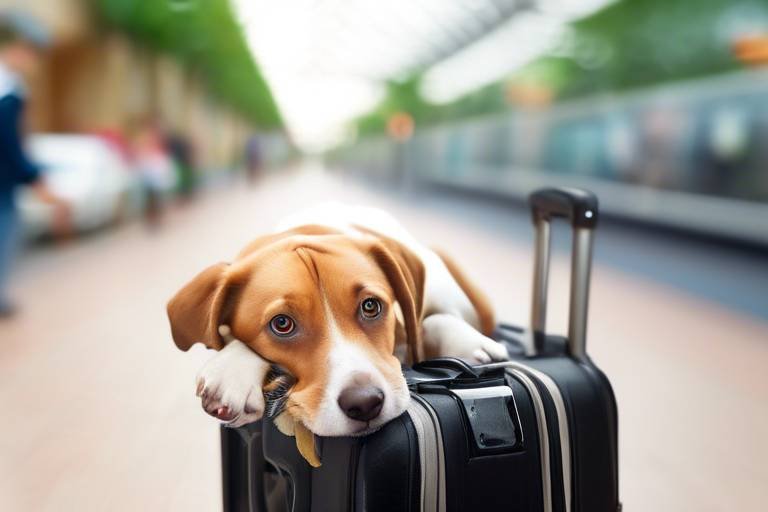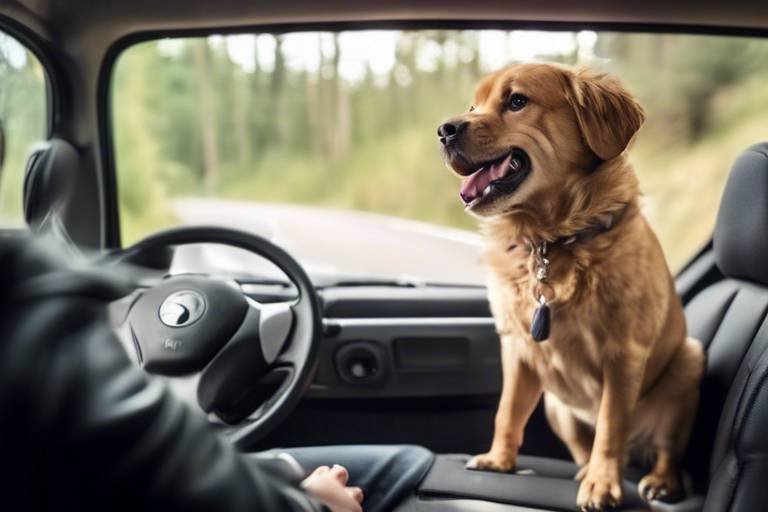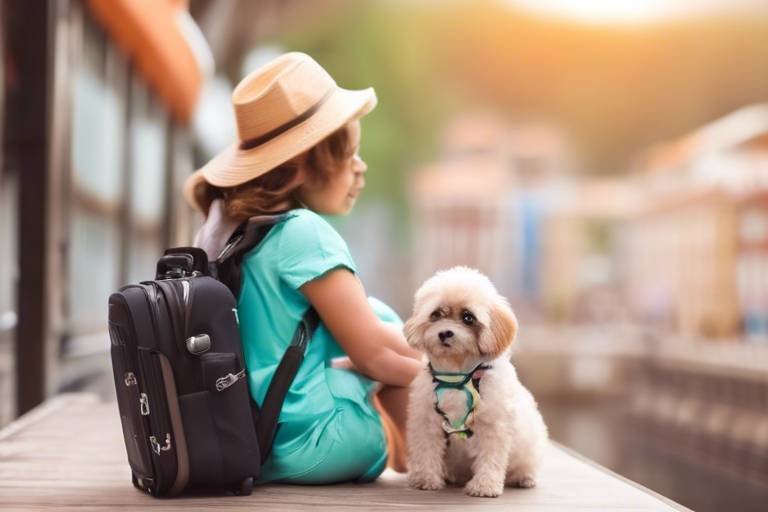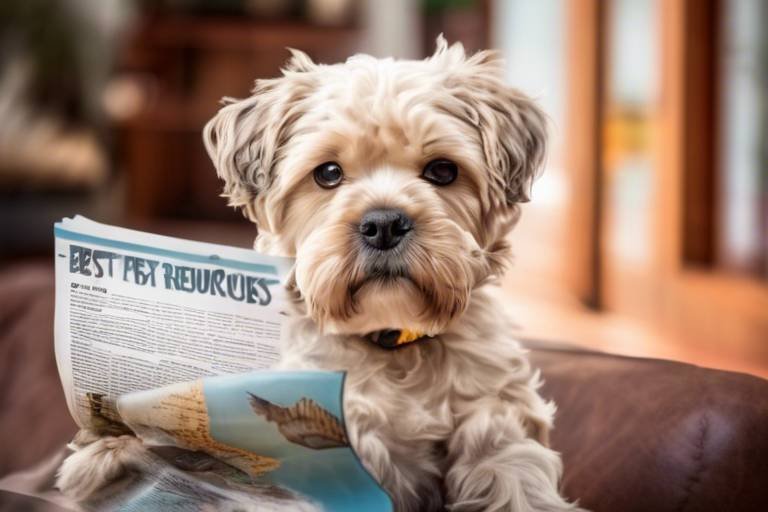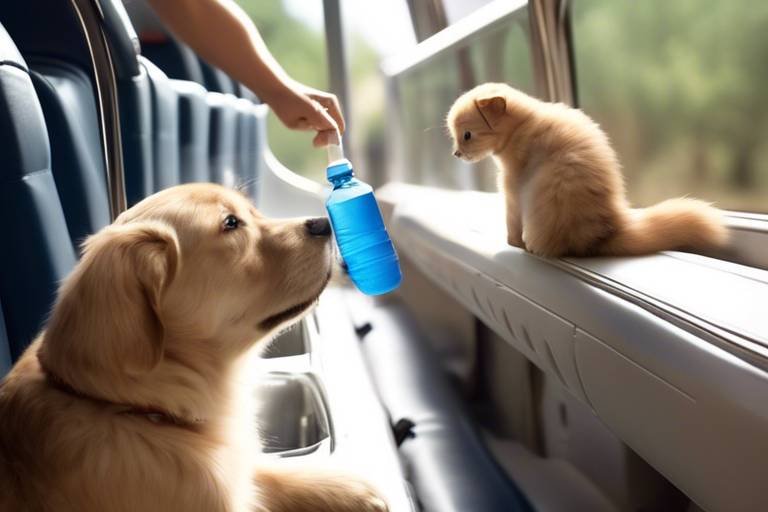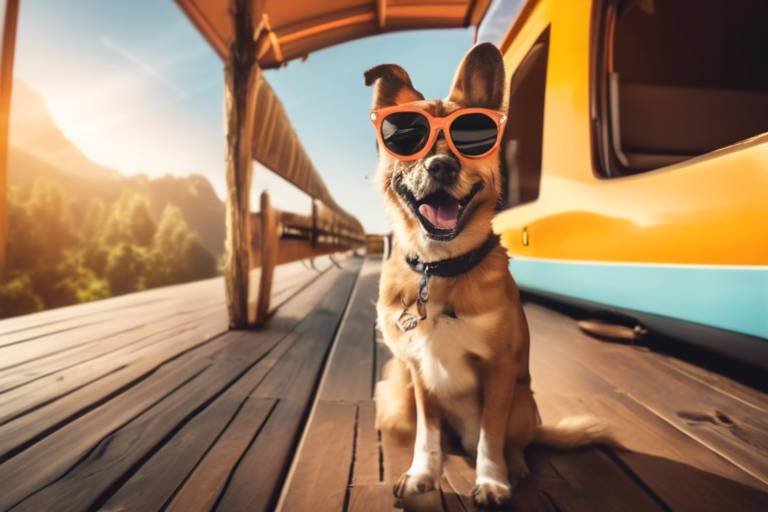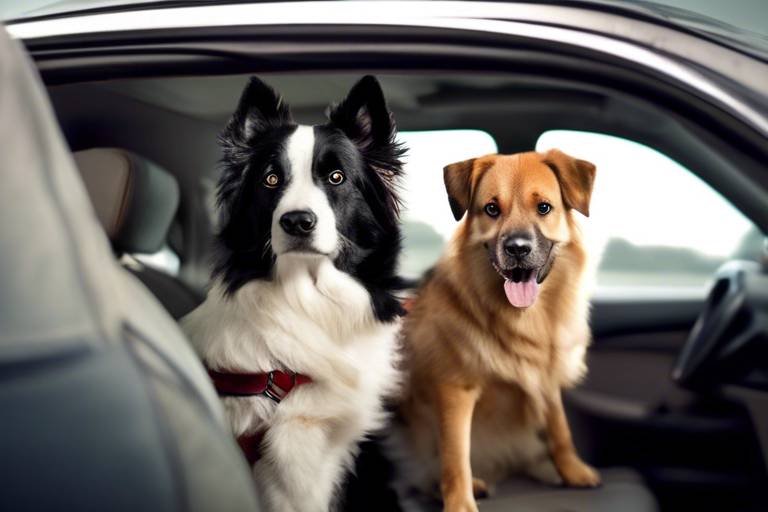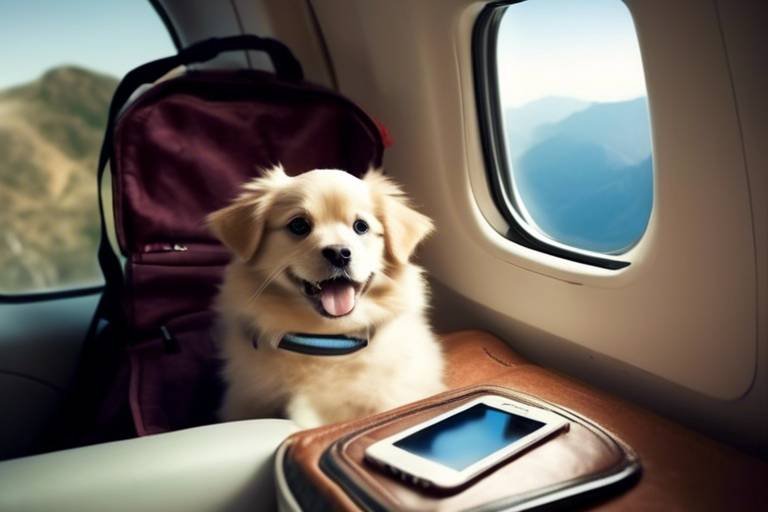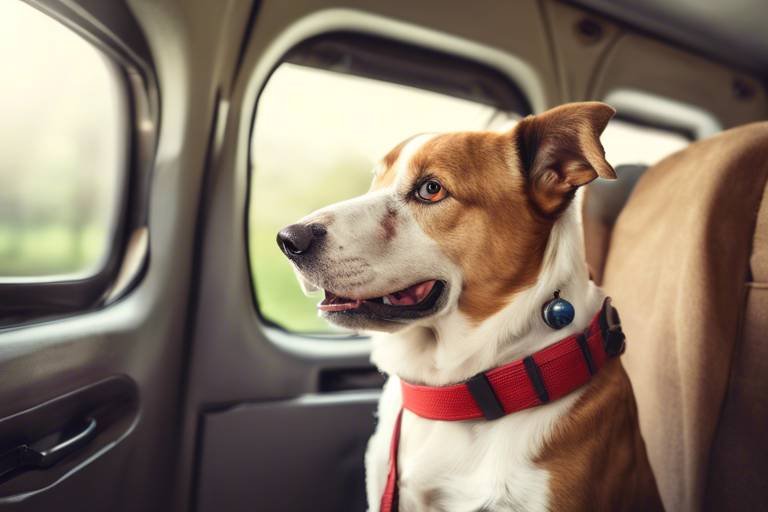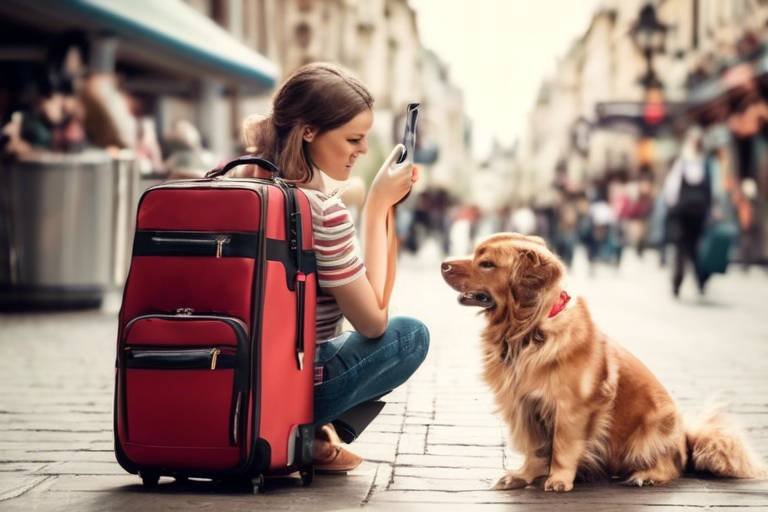Tips for Managing Travel-Related Pet Stress
Traveling with pets can be a delightful experience, but it often comes with its own set of challenges. Just like us, our furry companions can feel stressed and anxious when faced with new environments, strange sounds, and unfamiliar smells. The key to a successful trip lies in understanding how to manage this stress effectively. In this article, we will explore a variety of practical tips aimed at minimizing your pet's anxiety during travel, ensuring that both you and your pet enjoy the journey together.
First and foremost, it's important to recognize that pets communicate their discomfort in various ways. Signs of stress can manifest as excessive barking, whining, or even destructive behavior. Keeping an eye out for these behaviors can help you address your pet's needs promptly. Moreover, understanding the unique personality of your pet is essential. Some pets are naturally more anxious than others, and knowing your pet's temperament can guide you in choosing the best strategies to ease their stress.
Preparation is paramount when it comes to travel. Just like we wouldn't embark on a long road trip without planning our route, we shouldn't take our pets on a journey without adequate preparation. This includes familiarizing your pet with their travel carrier, gradually exposing them to car rides, and ensuring they are comfortable with the travel environment. By taking these steps, you can help your pet build confidence and reduce anxiety, making the journey smoother for everyone involved.
In the following sections, we will delve deeper into specific strategies for preparing your pet for travel, including choosing the right carrier, effective training techniques, and tips for both car and air travel. So, buckle up, and let’s get ready to explore how to make your pet's travel experience as enjoyable as possible!
Recognizing the signs of stress in pets is crucial for effective management. Many pet owners may overlook subtle cues that indicate their furry friends are feeling anxious. Common behaviors include pacing, excessive drooling, shaking, or hiding. By being attuned to these signs, you can take proactive measures to alleviate your pet's discomfort. For instance, if you notice your dog is panting heavily or your cat is meowing excessively, it might be time to take a break during your journey or provide some comforting distractions.
Preparation is key to reducing travel-related stress. Start by introducing your pet to their travel carrier well in advance of your trip. Make the carrier a cozy space by adding familiar bedding or toys. Allow your pet to explore the carrier at their own pace, and consider rewarding them with treats when they enter it willingly. Gradual exposure to the carrier will help them associate it with positive experiences, making it less intimidating when the time comes to travel.
Selecting an appropriate carrier can significantly impact your pet's comfort. Look for features such as ventilation, safety locks, and easy access. A carrier that is too small can make your pet feel cramped and anxious, while one that is too large may not provide the sense of security they need. When choosing a carrier, consider your pet’s size and weight, and ensure it meets airline regulations if you're flying.
The right size carrier ensures your pet has enough room to move. Measure your pet from nose to tail and from the ground to the top of their head when standing. A good rule of thumb is to choose a carrier that is at least a few inches longer and taller than your pet. This will allow them to sit, stand, and turn around comfortably. Remember, a comfortable pet is a happy pet!
Training your pet to feel comfortable in their carrier can alleviate stress. Start by leaving the carrier open in a common area of your home, allowing your pet to explore it freely. You can also use treats and toys to encourage your pet to enter the carrier. Gradually increase the time they spend inside, and consider taking short car rides with the carrier to help them get used to the motion. The goal is to create a positive association with the carrier, making it a safe haven for your pet.
Car travel presents unique challenges for pets. To make car journeys more enjoyable, consider the following tips: ensure your pet is secured with a seatbelt harness or in a carrier, take regular breaks for bathroom and stretch breaks, and keep the car well-ventilated. Additionally, bringing along their favorite blanket or toy can provide comfort during the ride. Always remember to never leave your pet alone in a parked car, as temperatures can rise quickly and pose serious health risks.
Flying with pets requires careful planning. Before booking your flight, check the airline's pet policy to ensure they accommodate animals. Some airlines offer pet-friendly flights, while others may have restrictions. It's crucial to prepare your pet for air travel by getting them used to their carrier and ensuring they are comfortable with the sounds and movements associated with flying.
Ensuring your pet's health during travel is paramount. Schedule a visit to the vet before your trip to confirm that your pet is in good health and up-to-date on vaccinations. Some airlines may require a health certificate, so be sure to check their requirements. Additionally, consider packing a travel health kit that includes essential items such as medications, food, and water to keep your pet safe and comfortable throughout the journey.
Anxiety can affect pets during travel. To manage anxiety, consider using calming products such as pheromone sprays, anxiety wraps, or natural supplements. Creating a routine before and during your trip can also help your pet feel more secure. For instance, feeding them at the same times each day and maintaining their normal walking schedule can provide a sense of stability amidst the chaos of travel.
- What are the signs that my pet is stressed during travel? Look for behaviors such as excessive barking, hiding, pacing, or drooling.
- How can I prepare my pet for air travel? Familiarize them with their carrier, ensure they are comfortable, and check airline policies regarding pets.
- What should I pack for my pet during travel? Include food, water, medications, a leash, and any comfort items like toys or blankets.
- Is it safe to sedate my pet for travel? Always consult your veterinarian before giving any sedatives, as they can have adverse effects.
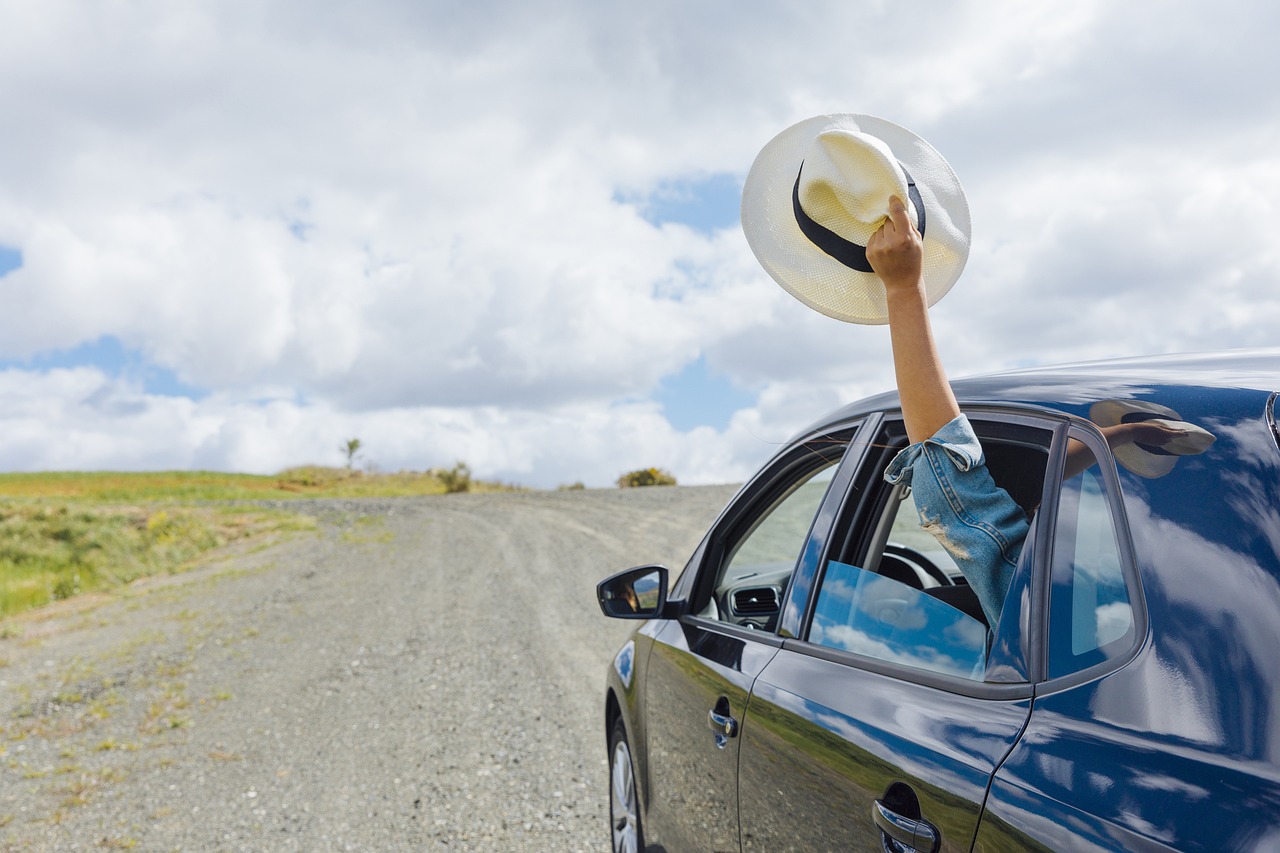
Understanding Pet Stress
When it comes to our furry friends, understanding their emotions is just as important as understanding our own. Pets, like humans, can experience stress, especially during travel. But how can you tell if your pet is feeling anxious or uncomfortable? Recognizing the signs of stress is crucial for effective management. Some common behaviors include excessive barking, whining, or even destructive actions. You might notice your pet pacing back and forth, hiding, or showing signs of aggression. These behaviors can be alarming, but they are your pet's way of communicating that something isn't right.
It’s important to remember that each pet is unique, and their reactions to stress can vary. For instance, while one dog might become overly excited and restless, another might retreat into a shell of quietness. In addition to behavioral changes, physical symptoms can also indicate stress. Keep an eye out for:
- Excessive panting – This can indicate anxiety, especially if it occurs without physical exertion.
- Drooling – While some drooling is normal, excessive drooling can be a sign of stress.
- Loss of appetite – If your pet suddenly refuses to eat, it could be due to anxiety.
- Shedding – Increased shedding can be a sign of stress, especially in cats.
Understanding these signs can help you intervene early and provide the support your pet needs. Just like us, pets thrive in environments where they feel safe and secure. If you notice your pet displaying any of these symptoms during travel, it’s essential to take action. Create a calm atmosphere by speaking softly, providing familiar items like their favorite blanket or toy, and ensuring they have a comfortable space to relax.
Additionally, consider the environment you’re traveling in. Loud noises, unfamiliar places, and even the presence of other animals can heighten your pet's stress levels. By being aware of these factors, you can better prepare for your journey and help your pet navigate through it with ease. Remember, the goal is to make travel an enjoyable experience for both you and your furry companion.

Preparing Your Pet for Travel
When it comes to traveling with your pet, preparation is everything! Imagine gearing up for a big trip without packing your essentials—chaos, right? The same goes for our furry friends. They need a little extra TLC to ensure they feel safe and secure during the journey. Start by introducing your pet to the travel environment well in advance. This means allowing them to explore their carrier and getting them used to the sights and sounds they’ll encounter on the road or in the air. The more familiar they are, the less anxious they’ll be!
One effective way to prepare your pet is through gradual exposure. Begin with short car rides, gradually increasing the duration as your pet becomes more comfortable. This not only helps them acclimate but also builds positive associations with travel. You can make these rides enjoyable by bringing along their favorite toys or blankets, creating a cozy atmosphere that reminds them of home. Remember, your pet is picking up on your energy, so stay calm and upbeat!
Another crucial aspect of preparation is to ensure you have all the necessary supplies ready. Think of it as packing for a vacation; you wouldn't leave home without your essentials! Here’s a quick checklist of items to consider:
- Comfortable carrier or harness
- Water and food bowls
- Food and treats
- Leash and collar with ID tags
- Familiar toys or blankets
- Health records and medications
Having these items on hand can make a world of difference in your pet's comfort level. And don’t forget to check if your destination is pet-friendly! Knowing where you can take your pet and what activities are available can help ease your mind and make the trip more enjoyable for both of you.
As you prepare, it’s also crucial to consider your pet’s individual needs. Some pets may require more time to adjust than others. For instance, if your furry friend is particularly anxious, you might want to consult your veterinarian about calming aids or medications that could help ease their nerves. Just like how some people need a little extra support before a big event, pets can benefit from similar care!
In summary, preparing your pet for travel involves a combination of familiarization, gradual exposure, and ensuring you have all the necessary supplies at your fingertips. By taking these steps, you can create a positive travel experience that minimizes stress and maximizes the fun for both you and your pet. Now, let’s dive into some specific tips on selecting the right carrier!
Choosing the Right Carrier
When it comes to traveling with your beloved pet, choosing the right carrier is not just a matter of convenience; it's a crucial step in ensuring your pet's comfort and safety. Imagine your furry friend nestled in a cozy space that feels like their own little sanctuary, rather than being tossed around in a clunky, uncomfortable box. The ideal carrier can make all the difference in reducing stress for both you and your pet. But how do you choose the right one? Let's break it down.
First and foremost, size matters. Your pet should have enough room to stand, turn around, and lie down comfortably. If your pet feels cramped, they’re likely to become anxious. To find the perfect size, measure your pet from the tip of their nose to the base of their tail and from the floor to the top of their head when they are standing. Add a few inches to these measurements to ensure they have space to move around. Here's a quick reference table to help you choose the right carrier size based on your pet's measurements:
| Pet Size | Carrier Dimensions (L x W x H) |
|---|---|
| Small (up to 10 lbs) | 18" x 12" x 10" |
| Medium (10-25 lbs) | 24" x 16" x 14" |
| Large (25-50 lbs) | 30" x 20" x 19" |
Next, consider the material of the carrier. Soft-sided carriers are great for small pets and provide a cozy environment, but they may not be suitable for larger or more active animals. Hard-sided carriers offer more protection and are often required for air travel. Look for carriers made from durable materials that can withstand wear and tear, especially if your pet tends to chew or scratch. Additionally, ensure the carrier has proper ventilation; mesh panels and air holes are essential for keeping your pet comfortable during the journey.
Another important feature to look for is security. A good carrier should have a secure locking mechanism to prevent your pet from escaping, especially in busy travel environments. You wouldn't want your pet to go on an unexpected adventure while you're distracted! Also, consider carriers with a top opening; this can make it easier to get your pet in and out, especially if they’re a bit hesitant.
Lastly, introducing the carrier to your pet is just as important as choosing the right one. Start by placing the carrier in a familiar area at home, leaving the door open and allowing your pet to explore it at their own pace. You can make it more inviting by adding their favorite blanket or toy inside. Gradually, you can encourage your pet to spend time in the carrier by rewarding them with treats and praise. This way, they’ll associate the carrier with positive experiences, making travel a breeze!
In conclusion, selecting the right carrier is a vital step in ensuring a stress-free travel experience for your pet. Remember to consider size, material, security, and how you introduce the carrier to your furry friend. With the right preparation, your pet can feel safe and comfortable, allowing you both to enjoy the journey ahead!
- What size carrier do I need for my pet? Measure your pet and refer to the size chart to find the best fit.
- Can I use a soft-sided carrier for air travel? It depends on the airline's regulations; always check their specific requirements.
- How can I make my pet feel comfortable in the carrier? Introduce the carrier gradually and use treats and familiar items to create a positive association.
Size and Comfort
When it comes to choosing a carrier for your pet, are absolutely paramount. Just like you wouldn’t want to squeeze into a pair of shoes two sizes too small, your furry friend deserves a space where they can stretch out and feel at ease during travel. A well-sized carrier not only provides comfort but also ensures safety, so let’s dive into how to find the perfect fit for your pet.
First things first, measuring your pet is essential. You want to ensure that the carrier is large enough for them to stand up, turn around, and lie down comfortably. To get the right measurements, follow these simple steps:
- Height: Measure your pet from the ground to the top of their head while they are standing.
- Length: Measure from the tip of their nose to the base of their tail.
- Width: Measure across their body at the widest point.
Once you have these measurements, you can refer to the carrier's specifications. Most manufacturers provide guidelines on the appropriate size based on the weight and dimensions of your pet. For example, a carrier designed for a small dog might accommodate pets weighing up to 15 pounds, while a large cat may need something that supports up to 20 pounds. Always opt for a carrier that exceeds your pet's measurements slightly to allow them some wiggle room.
Another vital aspect is the materials used in the carrier. Look for carriers made from breathable materials that allow for ventilation. This is especially important during long trips, as it helps keep your pet cool and comfortable. Additionally, a carrier with a soft, padded bottom can provide a cozy resting place for your pet, making them feel more secure and relaxed.
Comfort features can also include removable and washable liners. Accidents happen, and having a carrier that is easy to clean can save you a lot of hassle. Plus, you can add familiar bedding or toys to the carrier, which can help your pet feel more at home during the journey.
In summary, choosing the right size and ensuring comfort in your pet's carrier is crucial for a stress-free travel experience. By taking the time to measure your pet and select a carrier that meets their needs, you can significantly reduce anxiety and make travel a more enjoyable experience for both you and your furry companion.
Q: How do I know if my pet is comfortable in their carrier?
A: Signs of comfort include your pet lying down, exploring the carrier willingly, and not showing signs of stress such as whining or excessive panting. If your pet seems relaxed, you’re on the right track!
Q: What if my pet doesn't want to enter the carrier?
A: Gradual exposure is key. Start by placing the carrier in a familiar area and allowing your pet to explore it at their own pace. You can also entice them with treats or toys to create a positive association.
Q: Is it necessary to get a carrier with wheels?
A: While not essential, a wheeled carrier can be beneficial for larger pets or long-distance travel. It can make maneuvering through airports or train stations much easier.
Carrier Training Techniques
Training your pet to feel comfortable in their carrier is essential for reducing stress during travel. Think of the carrier as a cozy little den, a safe haven where your pet can retreat and feel secure. The goal here is to create a positive association with the carrier, transforming it from a source of anxiety into a place of comfort. To begin this process, start by introducing the carrier in a low-pressure environment. Place it in a familiar space, such as your living room, and leave the door open so your pet can explore it at their own pace.
Next, you can enhance the appeal of the carrier by adding soft bedding or your pet's favorite blanket. This will not only make the carrier more inviting but also provide a sense of familiarity. To further encourage your pet to enter the carrier, you might consider using treats or toys. Toss a few treats inside, allowing your pet to discover them on their own. This method reinforces the idea that the carrier is a rewarding place to be. Remember, patience is key here; don’t rush the process. Allow your pet to explore the carrier at their own pace without forcing them inside.
Once your pet is comfortable entering the carrier, it's time to introduce short practice sessions. Close the door for just a few moments while you stay nearby. Gradually increase the time they spend inside the carrier, always rewarding them with treats and praise when they remain calm. This process helps your pet associate the carrier with positive experiences. You might also want to simulate travel by gently moving the carrier around your home or taking short trips in the car. This will help your pet get used to the sensation of being transported in their carrier.
Additionally, consider the following techniques to further ease your pet into carrier training:
- Calm Environment: Keep the training sessions calm and quiet to avoid overwhelming your pet.
- Routine: Establish a regular routine for carrier training, which can help your pet feel more secure.
- Positive Reinforcement: Always use treats, praise, and affection to reward your pet for entering and staying calm in the carrier.
Incorporating these training techniques not only helps your pet feel more at ease with their carrier but also builds their confidence and trust in you as their owner. Just like teaching a child to ride a bike, the more practice and positive reinforcement they receive, the more comfortable they will become. So take your time, be patient, and watch as your pet transforms their perception of the carrier from a cage to their personal travel sanctuary.
Q: How long should I train my pet to use the carrier?
A: Training can vary based on your pet's personality. Some may adapt quickly, while others may need a few weeks. Consistency and patience are crucial.
Q: What if my pet refuses to enter the carrier?
A: If your pet is hesitant, try enticing them with their favorite treats or toys. Gradually increase the time they spend near the carrier to build their confidence.
Q: Can I use the carrier for other activities outside of travel?
A: Absolutely! Using the carrier for short periods during playtime or as a resting place can help your pet see it as a safe and enjoyable space.
Traveling by Car
Traveling by car with your furry friend can be a delightful adventure, but it also comes with its own set of challenges. Just like you might feel uneasy about a long road trip, your pet can experience similar emotions. Imagine being confined in a space, watching the world zoom by, and not fully understanding what's happening—it's no wonder pets can feel stressed during car rides! To make the journey enjoyable for both you and your pet, it’s essential to implement some thoughtful strategies.
First and foremost, familiarization is key. Before embarking on your journey, take some time to introduce your pet to the car environment. Allow them to explore the vehicle while it’s parked in your driveway. Open the doors, let them sniff around, and even encourage them to hop inside for a few minutes. This will help them associate the car with a safe and familiar place rather than a moving cage of uncertainty.
Next, consider the duration of the trip. Long hours in the car can be taxing for both pets and humans. If you’re planning a long drive, try to break it up into manageable segments. Schedule regular stops every couple of hours to let your pet stretch their legs, hydrate, and relieve themselves. A quick game of fetch or a short walk can do wonders to alleviate any pent-up energy and anxiety.
Another important aspect is ensuring your pet's comfort during the ride. Make sure they have a cozy blanket or their favorite toy with them. This can provide a sense of security and familiarity. Additionally, consider using a pet seatbelt or a well-ventilated carrier to keep them safe. Not only does this prevent them from roaming around the car, but it also minimizes the risk of injury in case of sudden stops. Remember, safety first!
Moreover, if your pet tends to get car sick, it’s crucial to take precautions. You might want to consult your veterinarian about possible medications that can help with motion sickness. Also, try to keep the car well-ventilated and avoid feeding your pet a heavy meal right before the trip. A light snack or their regular meal a few hours before hitting the road is usually a safer bet.
Lastly, don't forget to monitor your pet's behavior during the trip. If you notice signs of distress, such as whining, pacing, or excessive drooling, take a moment to pull over and check on them. Sometimes, a simple reassurance or a gentle scratch behind the ears can make a world of difference. Remember, your calm demeanor can help soothe your pet's nerves, so try to stay relaxed and enjoy the journey together!
- What should I do if my pet gets anxious during car rides? - If your pet shows signs of anxiety, consider using calming products like pheromone sprays or anxiety wraps. Regular breaks can also help alleviate their stress.
- Is it safe to let my pet stick their head out the window? - While it may seem fun, it’s best to keep your pet inside the vehicle with the windows rolled up to avoid potential injuries or distractions.
- How can I prevent my pet from getting car sick? - Consult your vet for advice on motion sickness medications. Additionally, feeding your pet a light meal a few hours before travel can help.

Air Travel Considerations
When it comes to air travel with pets, preparation is everything. Unlike a simple car ride, flying can be a whole different ball game for your furry friends. The hustle and bustle of airports, the noise of engines, and the confined spaces of aircraft can all contribute to a stressful experience for your pet. To ensure a smooth journey, it's vital to consider a few key factors that will help alleviate anxiety and make the trip more enjoyable for both you and your pet.
First off, airline policies regarding pet travel can vary significantly. Some airlines allow pets in the cabin, while others may require them to be transported in the cargo hold. It's essential to check the specific regulations of the airline you plan to use well in advance of your travel date. This will not only help you prepare but also prevent any last-minute surprises. Make sure to gather information on:
- Pet size and weight restrictions
- Carrier specifications
- Additional fees associated with pet travel
- Health documentation requirements
Next, consider the temperature and environment your pet will be exposed to during the flight. The cargo area can sometimes experience extreme temperatures, which can be dangerous for pets. If your pet must travel in the cargo hold, try to book direct flights to minimize the time spent in transit. Additionally, choose flights during cooler parts of the day, such as early morning or late evening, to help keep your pet comfortable.
Another critical aspect is preparing your pet for the journey. Familiarizing your pet with their carrier before the trip can make a world of difference. Spend time getting them comfortable inside the carrier, allowing them to explore it at home, and even feeding them meals in it. This way, when the time comes to travel, they’ll associate the carrier with positive experiences rather than just as a means of confinement.
As you embark on your journey, don’t forget to pack a travel kit for your pet. This kit should include essentials such as:
- Food and water
- Bowls for feeding
- Leash and harness
- Waste bags
- Favorite toys or blankets for comfort
Finally, consider your pet's health and safety during the flight. Schedule a visit to the vet before your trip to ensure your pet is healthy enough to fly. Your vet may recommend vaccinations or medications to help manage anxiety or motion sickness. Having a health certificate may also be required by the airline, so be sure to ask about this during your visit.
Q: Can I take my pet in the cabin with me?
A: Many airlines allow small pets in the cabin, provided they fit in an approved carrier that fits under the seat in front of you. Always check with the airline for specific requirements.
Q: What should I do if my pet gets anxious during the flight?
A: Consider using calming products like pheromone sprays or anxiety wraps. Consult your vet for recommendations on medications if your pet has severe anxiety.
Q: How can I prepare my pet for the noise and activity of the airport?
A: Gradually expose your pet to similar environments, such as busy public spaces or even mock airport trips. This can help them acclimate to the sounds and sights they will encounter.
By paying attention to these air travel considerations, you can help ensure a more peaceful and enjoyable experience for your pet. Remember, a little preparation goes a long way in reducing travel-related stress!
Health and Safety Precautions
When it comes to traveling with your beloved pets, prioritizing their health and safety is non-negotiable. Before you hit the road or board a plane, it’s essential to ensure your furry friend is in top-notch condition. This means scheduling a visit to the vet to confirm that your pet is healthy enough for travel. It's also a great opportunity to discuss any specific concerns you might have, such as motion sickness or anxiety, which can be particularly relevant during travel.
One of the first things to consider is ensuring that your pet is up to date on vaccinations. Most airlines and hotels require proof of vaccination, especially for rabies. Additionally, having a health certificate from your vet can be a lifesaver, particularly for air travel, as many airlines mandate this document. It’s like having a passport for your pet—without it, you might face some serious travel hiccups!
Another crucial aspect of health and safety is identifying any potential risks associated with your travel destination. For example, if you’re heading to a region known for ticks or fleas, make sure your pet is protected with the appropriate preventive treatments. It's always better to be safe than sorry, right?
Here are some key health and safety precautions to keep in mind:
- Vaccinations: Ensure your pet's vaccinations are current and obtain any necessary certificates.
- Microchipping: If your pet gets lost, microchipping can be a lifesaver. It's a quick and painless procedure that can help reunite you with your furry friend.
- Emergency Kit: Pack a travel emergency kit that includes basic first aid supplies, medications, and any special dietary needs your pet may have.
- Hydration: Keep your pet hydrated, especially during long trips. Bring along a portable water bowl and offer water frequently.
Additionally, consider your pet's comfort during travel. If you're flying, it’s important to know the airline's pet policies, including crate requirements and in-flight care. If you're driving, make frequent stops to let your pet stretch their legs and relieve themselves. Remember, a happy pet makes for a happy journey!
Lastly, maintaining a routine can help alleviate some of the anxiety your pet may experience during travel. Try to stick to their regular feeding and bathroom schedule as closely as possible. This familiarity can be incredibly reassuring for them in an otherwise chaotic environment.
By taking these health and safety precautions, you can ensure that your pet travels in comfort and style, allowing you both to enjoy the adventure ahead!
- What vaccinations does my pet need before traveling?
Most importantly, ensure your pet is up to date on rabies vaccinations. Depending on your destination, other vaccinations may be required. - Should I get my pet microchipped before traveling?
Yes! Microchipping is a great safety measure in case your pet gets lost during your travels. - How can I keep my pet calm during travel?
Maintaining a routine, using calming products, and providing familiar items from home can help reduce anxiety.
Managing Anxiety During Travel
Traveling with your beloved pet can be a delightful adventure, but it can also bring about feelings of anxiety for both you and your furry friend. Just like us, pets can experience stress when faced with new environments, sounds, and routines. So, how can we ease their worries and make the journey smoother? Here are some effective strategies to consider.
First and foremost, creating a calming environment is essential. This means ensuring your pet has a quiet space in the vehicle or carrier where they can feel safe. You might want to bring along their favorite blanket or toy—something that smells like home. Familiar scents can provide comfort and help reduce anxiety levels. Imagine how you would feel holding onto a cherished item in a new and overwhelming place; your pet feels the same way!
Another effective method is to maintain a consistent routine. Animals thrive on routine, and unexpected changes can lead to stress. Before the trip, try to keep feeding, walking, and playtimes consistent. During travel, aim to stick to the usual schedule as much as possible. If you can, plan breaks during long car rides to allow your pet to stretch, relieve themselves, and relax. Think of it like a pit stop for a race car; it keeps everything running smoothly!
Additionally, consider using calming products. There are various options available, such as calming sprays, pheromone diffusers, or even anxiety wraps. These products can help create a soothing atmosphere for your pet. Always consult with your vet before trying new products to ensure they are safe and suitable for your pet’s specific needs.
Moreover, desensitization techniques can be quite beneficial. If your pet is particularly anxious about travel, try taking them on short car rides leading up to your trip. Gradually increase the duration of these rides, rewarding your pet with treats and praise to create positive associations with travel. This method is akin to training for a marathon; you start small and build up to the big event!
Lastly, never underestimate the power of your presence. Your calm demeanor can significantly influence how your pet feels. If you’re anxious, your pet will likely pick up on that energy. Speak softly, offer gentle pets, and reassure them that everything is okay. Just like a child looks to their parent for comfort in a scary situation, your pet relies on you for reassurance during travel.
- How can I tell if my pet is anxious during travel?
Look for signs such as excessive barking, whining, pacing, or attempts to escape their carrier. If your pet is trembling or has a tucked tail, these are also indicators of anxiety. - Are there any medications for travel anxiety?
Yes, there are medications available that can help manage your pet’s anxiety. Consult your veterinarian for recommendations tailored to your pet’s needs. - Can I use natural remedies for my pet's anxiety?
Absolutely! Many pet owners find success with natural remedies like CBD oil or herbal supplements. Again, it’s best to discuss these options with your vet.
Frequently Asked Questions
- What are the signs of stress in pets during travel?
Recognizing stress in your furry friend is crucial for a smooth journey. Common signs include excessive barking, panting, drooling, or hiding. You might also notice changes in their eating or sleeping habits. If your pet seems restless or overly clingy, they might be feeling anxious.
- How can I prepare my pet for travel?
Preparation is key! Start by familiarizing your pet with their carrier well in advance. Allow them to explore it, and consider placing their favorite blanket or toy inside. Gradually take them on short car rides to help them adjust to the travel environment. The more comfortable they feel, the less stress they will experience.
- What features should I look for in a pet carrier?
When selecting a carrier, size and comfort are paramount. Make sure it's spacious enough for your pet to stand, turn around, and lie down comfortably. Look for carriers with good ventilation, secure latches, and easy access. A cozy interior can also make a big difference in your pet's comfort level.
- How can I train my pet to use their carrier?
Carrier training can be a game-changer! Start by making the carrier a positive space. Use treats, toys, and praise to encourage your pet to enter the carrier willingly. Gradually increase the time they spend inside, and take short trips to help them associate the carrier with fun adventures.
- What should I consider when traveling by car with my pet?
Car travel can be a breeze with the right preparation! Ensure your pet is secured in their carrier or with a pet seatbelt. Take regular breaks to allow them to stretch and relieve themselves. Keep the car well-ventilated and avoid feeding them a large meal right before the trip to prevent motion sickness.
- What are the key considerations for air travel with pets?
Flying with pets requires extra planning. Check airline policies regarding pet travel and book a pet-friendly flight. Ensure your pet is comfortable in their carrier and consider using calming products if they're prone to anxiety. Don’t forget to have all necessary health documents ready!
- What health precautions should I take before traveling with my pet?
Before hitting the road or sky, ensure your pet is up-to-date on vaccinations and has a recent health check-up. Consult your vet for any specific health concerns, and consider getting a health certificate if required by your travel destination. Keeping your pet healthy is the first step to a stress-free trip!
- How can I manage my pet's anxiety during travel?
Managing anxiety is essential for a peaceful journey. Consider using calming products like pheromone sprays or anxiety wraps. Keeping a consistent routine, like feeding and potty breaks, can also help. Remember, your calm demeanor will reassure your pet, so stay relaxed and positive!

